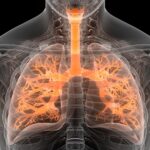A new meta-analyses shows how exercise therapy can be used for the symptomatic management of COPD.
Growing evidence suggests that physical rehabilitation is a beneficial intervention for patients suffering from symptoms of COPD, and it can be as effective as pharmacotherapies in improving their quality of life when adapted to each patient’s specific physical abilities.
“Pulmonary rehabilitation should be prescribed to those patients that remain symptomatic despite optimal pharmacotherapy and to patients that suffer from exacerbations,” the authors wrote in The European Respiratory Review.
It should also “be tailored to the patient’s limitations, possibilities, goals and preferences” where possible, they added.
The meta-analysis found that a combination of aerobic exercises and resistance training, such as weightlifting, as a part of physical rehabilitation could reduce fatigue and improve cardiac output, with effects seen in 6-8 weeks. The biggest improvements were seen in patients engaging in high-intensity training.
Interventions such as optimal bronchodilator therapy, volume reduction using endobronchial valves and non-invasive ventilation such as nose-mouth interfaces all contributed to increasing the ventilatory abilities of patients, and helped to make exercise more comfortable and achievable given their limitations.
To reduce the ventilatory burden of exercise, oxygen supplements were found to reduce lactate levels in patients without mild hypoxia, allowing them to maintain saturation and better cope with the physical burden of exercise. However, data was conflicting, and results suggested carefully selecting patients for oxygen therapy based on their saturation and desaturation levels at rest and during exercise may be the key to improving endurance time.
Interval training was found to be a relatively comfortable form of exercise for patients, and beneficial in a range of other chronic diseases, particularly improving glycaemic control, vascular health and systemic inflammatory markers.
Dyspnoea is a common side effect for COPD patients who engage in physical exercise, usually exacerbated by the poor gas exchange which results in discomfort and breathlessness, giving many patients plenty of reasons to avoid exercising. However, consistently shunning exercise was likely to do more harm than good, the authors said.
“While the strategy of exercise avoidance provides immediate comfort, it is a fatal strategy for the human body in the long term,” the authors wrote.
COPD patients suffer from day-to-day problems that go beyond the physical limitations of their condition, such as anxiety, depression, social isolation and loneliness.
“[Physical rehabilitation] is a comprehensive program that aims to improve patients’ symptoms, independence and wellbeing,” said Dr Jin-Gun Cho, senior staff specialist at the department of respiratory and sleep medicine, Westmead Hospital.
“The education [component] will cover things like diet, how to manage breathlessness, energy conservation, how to use the inhalers properly, [and] provides education for the patient so that they’re empowered to manage the condition better,” he told TMR.
When implementing exercise therapy, a range of adaptations could also be made to existing exercises to make them more suitable for the needs of COPD patients.
“One-legged cycling is another way to reduce the ventilatory burden of exercise. By focussing the exercise on a single leg, the metabolic burden of exercise is reduced and allows for a higher workload on the leg at work,” the authors wrote.
The paper also made recommendations for adapting pulmonary rehabilitation methods for patients living with COPD in different scenarios.
For stable patients, the benefits of exercise therapy were “undisputed”, according to the authors. For example, the Cochrane media release accompanying its 2015 meta-analysis said no further research was needed to support the benefits of exercise therapy.
However, questions on how to make it more accessible and readily available for all patients remain.
According to Dr Cho, telehealth appeared to be a solution to high demand and waiting lists.
“There have been ways to reduce demand by offering home-based programs, with research focused in Victoria where they’ve been leading the way in home pulmonary rehabilitation using telehealth, which has been shown to be as effective as centre-based [programs],” he said.
In contrast, physical rehabilitation following surgery isn’t backed up by the same amount of evidence. Although it’s tempting to assume that the post-surgery improvement in ventilatory capacity may be the best time to “enhance physical fitness”, the authors noted that “the best timing for rehabilitation interventions in patients receiving volume reduction remains an important question in search for resolution.”
However, some evidence suggests potential improvements, such as a recent studies showing improved blood pressure and bone health in patients who took up exercise training after receiving lung transplants.
Furthermore, the authors added that in a scenario with patients experiencing COPD symptom exacerbations, they deserve special attention and their specific needs must be considered before making exercise therapy recommendations, taking their “frailty and reduced ventilatory capacity” as well as the possibility of potential relapses into account.
Referring to a study that found only 1.5% of patients started exercise therapy within three months of being discharged, the authors highlighted the need for “innovative programme formats and better patient and clinician education” to improve access.
Dr Cho agreed that accessibility was important, reflecting on anecdotal instances when patients were deterred from trying exercise therapy by their primary carers who warned that it would exacerbate their breathlessness.
“[Primary clinicians] need to remind themselves that pulmonary rehabilitation after an exacerbation of COPD is definitely recommended, and there’s great evidence to show that it is of benefit,” he commented.
There are still questions surrounding which phenotypes of patients receive the greatest benefit from exercise therapy, and how much the optimisation of such programs for the needs of each patient will improve their symptoms. Additionally, Dr Cho added that it’s uncertain how long the benefits of an eight-week rehabilitation program would last, but he said it is not a one-off solution.
“If you give a patient with COPD a course of rehab, they get a boost in terms of capacity, breathlessness, anxiety and depression, but those effects will wear off over time. And so, unless there is some other kind of program that’s ongoing, they will have those symptoms coming back. The key is how to maintain those benefits over time. That’s one of the [current] research areas.”





